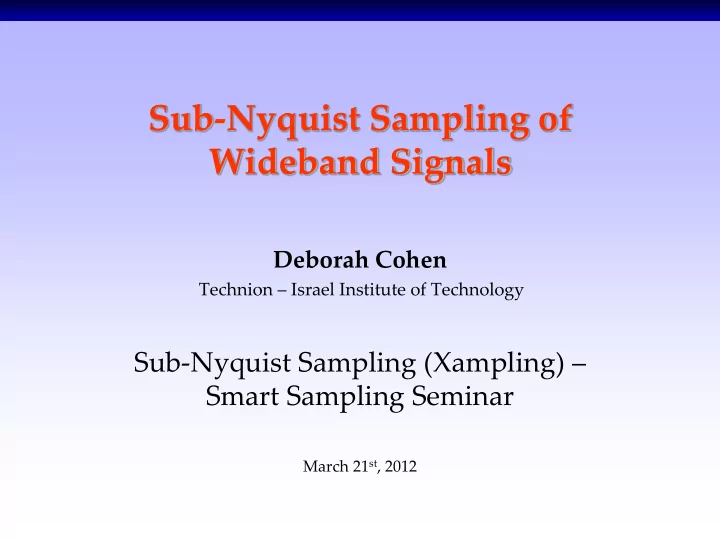

Sub-Nyquist Sampling of Wideband Signals Deborah Cohen Technion – Israel Institute of Technology Sub-Nyquist Sampling (Xampling) – Smart Sampling Seminar March 21 st , 2012 1 /20
Outline Motivation Algorithms Sampling: MWC and Multicoset Recovery Challenges and Trade-Offs Treatment of Noise 2
Spectrum Saturation Licensed frequency bands to Primary Users (PUs): TV, radio stations, mobile carriers, air traffic control…) Spectrum is too crowded Cannot allocate frequency bands to new users! 3
Spectrum Sparsity Spectrum is underutilized In a given place, at a given time, only a small number of PUs transmit concurrently Shared Spectrum Company (SSC) – 16-18 Nov 2005 Can we exploit temporarily available spectrum holes for opportunistic transmissions? 4
Cognitive Radios Principle: Perform spectrum sensing to search for available spectrum holes Monitor spectrum during transmission to detect any change in PUs’ activity Requirements: Wideband spectrum sensing Real-time Reliability Minimal hardware and software resources (mobile) Nyquist sampling is not an option! How do we efficiently perform detection on a wideband signal? 5
Model ~ ~ ~ ~ Multiband model: N – max number of transmissions B – max bandwidth of each transmission Goal: blind detection Minimal achievable rate: 2NB << f NYQ 6
The Modulated Wideband Converter (MWC) Mishali & Eldar ‘ 10 ~ ~ ~ ~ p t i y n i 7
MWC – Mixing & Aliasing Mixing function periodic with period T p t p i Examples: 1 … -1 Frequency domain Practical considerations: Can’t design nice sign patterns at high frequency Only periodicity and frequency smoothness matter 8
MWC – Aliasing ~ ~ ~ ~ 9
MWC – Recovery ~ ~ A A S z f ~ ~ S y f z f Support S recovery † Signal reconstruction: z f A y f S S 10
MWC – Support Recovery (CTF) Problem: infinite number of linear systems (f is continuous) Solve in the time domain for each n: Time consuming Not robust to noise CTF (Continuous To Finite): Infinite problem (IMV) One finite-dimensional problem 11
MWC – Single Channel m channels at rate f s 1 channel at rate mf s A system with provides q f qf s p equations for each physical channel Trade-off: Fewer channels: big hardware savings Increased rate in each channel 12
Alternative: Multicoset Sampling Mishali & Eldar ‘ 09 Selection of certain samples from the 1 Nyquist grid at rate : f s MT , x n x nMT cT c M 0 1 c i i i 1 i m Time shifts t=nMT x n ∆ t=c 1 t c 1 t=nMT ∆ t=c m t x n c m 13
Multicoset vs. MWC Same… Minimal sampling rate Relation between samples and original signal Reconstruction scheme … But Different Difficult to maintain accurate time shifts Practical ADCs distort the samples Easier to implement – less hardware Solve digital bottleneck in case of low bandwidth 14
Sub-Nyquist Demonstration Mishali & Eldar , ‘ 10 Carrier frequencies are chosen to create overlayed aliasing at baseband + + Overlayed sub-Nyquist FM @ 631.2 MHz AM @ 807.8 MHz Sine @ 981.9 MHz aliasing around 6.171 MHz MWC prototype 10 kHz 100 kHz 1.5 MHz Reconstruction (CTF) FM @ 631.2 MHz AM @ 807.8 MHz 15
But… Joint work with Cores, UCLA Problem: High sensitivity to noise Energy detection fails in low SNR regimes Solution: New detection scheme Using a property of communication signals that is not exhibited by noise S f S f f f 16
Cyclostationarity Definition: Process whose statistical characteristics vary periodically with time Example: Communication signals Characterization: Spectral correlation function (SCF) Exhibits spectral peaks at certain frequency locations called cycle frequencies 17
SCF – Examples (Gardner) BPSK QAM Modulation Peaks at ( α ,f) MSK 1 1 BPSK , f , 2 f ,0 , 2 f ,0 c c c T T MSK 1 1 , f , 2 f ,0 c c T 2 T QAM 1 , f c AM T AM 2 f ,0 c 18
Results Cohen, Rebeiz et. Al, ‘ 11 1 0.9 0.8 0.7 Probability of Detection 0.6 0.5 0.4 0.3 Nyquist - SNR = 0 dB 0.2 Sub-Nyquist - SNR = 0 dB Sub-Nyquist - SNR = 5 dB 0.1 Nyquist - SNR = 5 dB 0 0 0.1 0.2 0.3 0.4 0.5 0.6 0.7 0.8 0.9 1 Probability of False Alarm Nyquist Sub-Nyquist f GHz 10 m f 30 12 MHz 360 MHz Sampling rate nyq s We can perform recovery from MWC samples in low SNR regimes using cyclostationary detection 19
Conclusions Cognitive radios: solve the spectrum congestion issue Crucial task: wideband analog spectrum sensing Sensing mechanism: low-rate, quick, efficient and reliable Robustness to noise: exploit communication signals cyclostationarity 20
References M. Mishali and Y. C. Eldar , “ Blind multiband signal reconstruction: Compressed sensing for analog signals ”, IEEE Trans. Signal Processing , vol. 57, pp. 993 – 1009, Mar. 2009. M. Mishali and Y. C. Eldar and M. Mishali , “ Robust recovery of signals from a structured union of subspaces ”, IEEE Trans. Inform. Theory, vol. 55, no. 11, pp. 5302-5316, November 2009. M. Mishali and Y. C. Eldar , “ From theory to practice: sub-Nyquist sampling of sparse wideband analog signals ”, IEEE Journal of Selected Topics on Signal Processing, vol. 4, pp. 375-391, April 2010. M. Mishali, Y. C. Eldar, O. Dounaevsky and E. Shoshan, “ Xampling: Analog to Digital at Sub- Nyquist Rates ”, IET Circuits, Devices & Systems, vol. 5, no. 1, pp. 8-20, Jan. 2011. M. Mishali and Y.C. Eldar , “ Wideband Spectrum Sensing at Sub-Nyquist Rates ”, IEEE Signal Processing Magazine, vol. 28, no. 4, pp. 102-135, July 2011. W. A. Gardner, “ Cyclostationarity in Communications and Signal Processing ”, ed. IEEE Press, 1994. D. Cohen, E. Rebeiz, V. Jain, Y.C. Eldar and D. Cabric , “ Cyclostationary Feature Detection from Sub-Nyquist Samples ”, IEEE CAMSAP, Dec. 2011. 21
Thank you 22
Recommend
More recommend